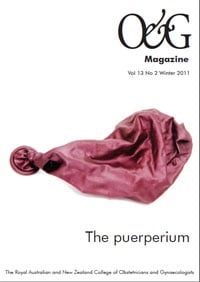A discussion of maternal death due to antenatal streptococcal toxic shock syndrome; a case of GAS causing fulminant sepsis, haemolysis and disseminated intravascular coagulation.
A maternal death is fortunately a rare event in the developed world. Group A streptococcus (GAS) has historically been a significant cause of obstetric morbidity and mortality. In the last 20 years, there has been a re-emergence of this organism as a significant obstetric pathogen. This article describes a clinical scenario that serves to remind us of the scientific principles, the pathogen and the pathogenesis of this infection.
The patient was at 26 weeks in her second pregnancy when she presented to hospital. Her previous pregnancy had been uncomplicated, ending in a full-term normal vaginal delivery. She had had, since childhood, nephritic syndrome secondary to focal glomerulo schlerosis diagnosed on biopsy. She had relapsed six months before presentation, but was well controlled on 30mg of Prednisone daily. In the index pregnancy, all antenatal investigations had been normal including renal function and urinalysis and ultrasonography.
In the 12 hours before her death, she saw her family doctor with mild flu-like symptoms. She was afebrile with a normal urine dipstick and was sent home with advice to take paracetamol. Over the next six hours she developed worsening abdominal pain with slight vaginal bleeding and presented to our hospital by ambulance. On arrival, her temperature was 36.9C, pulse rate 80bpm, BP 120/76, the fetal heart was heard; haemoglobin was 142g/L and platelets 204×109/L (neutrophils 1.9×109/L and lymphocytes 0.3×109). Biochemistry was unavailable due to gross haemolysis.
The initial clinical diagnosis was of placental abruption and threatened preterm labour. The patient was given analgesia, intravenous fluids, penicillin and steroids. One hour later, ultrasound was performed and an intrauterine death was diagnosed. Her condition rapidly deteriorated and she experienced progressive profuse blood-stained diarrhoea, fever, tachycardia, massive haemoptysis and subconjunctival haemorrhages and petechial haemorrhage and severe hypoxia. Treatment over this time included intravenous fluids, broad spectrum antibiotics and transfer to the intensive care unit.
Biochemistry and coagulation studies were again unavailable due to haemolysis, haemoglobin was 120, platelets 33, white cell counts 6.8, neutrophils 4.7, arterial pH 6.96, pO2 10.4kPa, bicarbonate 9mmol/L and base excess -23. The patient was intubated and ventilated, and inotropic support initiated. Five hours and 40 minutes after admission irreversible respiratory and cardiac arrest occurred.
A postmortem was performed. There was pulmonary haemorrhage, no placental abruption was found. Due to neutrophilic infiltration in the liver and myocardium, the most likely cause of disseminated intravascular coagulopathy (DIC) was sepsis. A microscopic focus of pyelonephritis may have identified a potential source, however, blood, urine and faecal cultures were negative. Vaginal swabs grew Streptococcus pyogenes.
S. pyogenes, a Lancefield haemolytic GAS, was a major cause of sepsis and death in the pre-antibiotic era. Recent literature has touted invasive GAS as a re-emerging threat. The incidence in developed countries has been estimated at 2.45–20 cases per 100,000 person-years1,2 and mortality estimated at 15–45 per cent.4 Guidelines define the diagnosis of GAS toxic shock syndrome (TSS or STSS), requiring isolation of GAS from a normally sterile site, hypotension and at least two of renal impairment, coagulopathy, liver involvement, adult respiratory distress, erythematous macular rash and soft tissue necrosis.5 If isolated from a non-sterile site the diagnosis is of ‘probable’ STSS.
A series of 30 cases of puerperal STSS have described a presentation similar to our case, with prodromal symptoms followed by severe abdominal pain. Coagulopathy was present in 77 per cent and haemolysis in 44 per cent of cases. The progression to sepsis, organ failure and coagulopathy is frequently rapid and often fatal, even with prompt, appropriate treatment. The majority died from DIC ‘and occasionally massive haemoptysis’. Cases presenting before or during labour, or within 12 hours of delivery were more likely to be fatal and less likely to have significant soft tissue infection.6
There are two predominant factors that contribute to the virulence of GAS; the M-proteins (cell membrane proteins used to subtype GAS) and the presence of exotoxins. Together, these act as super-antigens to render GAS resistant to phagocytosis, suppress IgM synthesis, stimulate T-cell response through major histocompatability complex (MHC) class II and subsequently produce a cytokine and lymphokine response. In isolation, some of these exotoxins work as haemolysins, which are toxic to erythrocytes, polymorphs, leukocytes, platelets, tissues culture cells and lysosomes, others facilitate the liquefaction of pus and the cleavage of tissue planes to enable spread of invasive infection.7
Current literature reports several recent cases of severe GAS sepsis since 1990, many of which have been successfully treated with penicillin alone8,9,10; however, current recommendations are to treat with both penicillin and clindamycin. Clindamycin is more effective with delayed treatment, has better tissue penetration and suppresses exotoxin and M-protein production.11,12 All strains of GAS are sensitive to penicillin and resistance to erythromycin is found in less than five per cent. There have been several small studies using immunoglobulin to treat STTS with varying results and more studies are needed in this area.
This case demonstrates a rapid, fulminant septic illness, most likely due to GAS, in a woman immuno-compromised due to pregnancy and long-term use of steroids. It serves to demonstrate an often forgotten, but significant, cause of morbidity and mortality that has seen a resurrection over the last 20 years.1 Early assessment and treatment are imperative, so increasing the awareness of the condition will be our best defence against the re-emerging cause of maternal morbidity and mortality.
References
- Carapetis JR. Steer AC. Mulholland EK. Weber M. The global burden of group A streptococcal disease. The Lancet Infectious Diseases Nov 2005; 5(11):685–94.
- Dennis L. Stevens. Streptococcal toxic shock syndrome: Spectrum of disease, pathogenesis and new concepts of treatment. Emerg.Infect. Disc1(3):69–78 July-Sept 1995.
- http://www.cdc.gov/ncidod/dbmd/diseaseinfo/groupastreptococcal_t.htm .
- Abouzeidl P. Wu N. Mohammed M. Al-Samarrai M. Group A streptococcal peurpural sepsis: the return of a potentially fatal disease. Journal of Obstetrics and Gynaecology. Nov 2005; 25(8):806–8.
- Defining the group a streptococcal toxic shock syndrome: Rationale and consensus definition. The working group on severe streptococcal infections. Journal American Med Assoc. 1993; 269:390.
- Udagawa, H. Oshio, Y. Shimizu, Y. Serious group A streptococcal infection around delivery. Obstetrics and Gynaecology. 94(1): 153–7, 1999 Jul.
- Bisno, Stevens. Streptococcus pyogenes. Principles and Practice of Infectious Diseases, 6th edition. Chapter 195.
- Okumura K. Schroff R. Campbell R. Nishioka L. Elster E. Group A streptococcal puerperal sepsis with retroperitoneal involvement developing in a late postpartum woman: case report. The American Surgeon. Aug 2004; 70(8):730–2.
- Morgan PJ. Maternal death following epidural anaesthetic for caesarean section delivery in a patient with unsuspected sepsis. Canadian Journal of Anaesthesia. Apr 1995; 42(4): 330–4.
- Soravia C. Romand JA. Herrmann M. Chevrolet JC. Ricou B. Suter. Group A beta-haemolytic streptococcus septicaemia: the toxic strep syndrome. Report of our cases developing septic shock and multiple organ failure. Intensive Care Medicine 1993; 19(1): 53–6.
- Stevens DL. Gibbons AE. Bergstrom R. Winn V. The Eagle effect revisited: efficacy of clindamycin, erythromycin and penicillin in the treatment of streptococcal myositis. J. Infect Dis July 1988; 158;23–8.
- Stevens DL. Bryant AE. Yan S. Invasive group A streptococcal infection: new concepts in antibiotic treatment. Int J Antimicrob Agents 1994; 4:297–301.







Leave a Reply